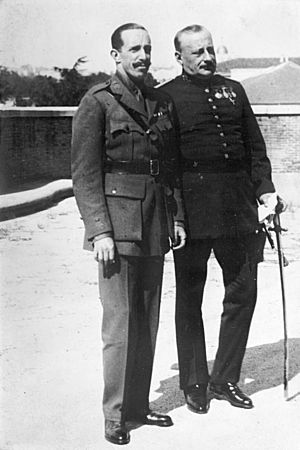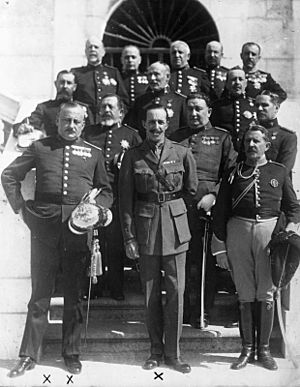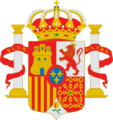Military directory of Primo de Rivera facts for kids
The Military Directory of Primo de Rivera was the first part of a period when Spain was ruled by a dictatorship under General Miguel Primo de Rivera. This happened during the time of King Alfonso XIII, after Primo de Rivera took power in a coup d'état (a sudden takeover of government) in September 1923. The Military Directory was a group made up only of military officers (eight generals and one admiral). General Primo de Rivera led this group, and they helped him make decisions and create new laws. The old Parliament (where elected representatives made laws) was closed.
In December 1925, the Military Directory was replaced by a new government called the Civil Directory. This new government also had military members but included civilians too. Primo de Rivera still led it. This second part of his dictatorship lasted until January 1930.
The Military Directory was different from fascism (like in Italy at the time). While it had a single political party, the government still controlled it, and the old powerful families kept their influence. However, it did share some ideas with fascism, like the idea of "corporatism," where different groups in society work together under the state's guidance.
During the Military Directory's time, two big problems were solved. First, the war in Morocco ended. Second, order was brought back to Catalonia, where there had been a lot of unrest. These were problems that the previous governments couldn't fix. After solving these, the "dictatorship with a king," as some historians called it, tried to create a new, more authoritarian political system with a single party called the Patriotic Union, similar to what was happening in Fascist Italy.
Contents
How the Military Directory Began
Since the disaster of 1898, the Army had been getting more involved in Spanish politics. Two important moments were the "Cu-Cut!" crisis in 1905, where soldiers attacked a newspaper, and the Spanish crisis of 1917, where military groups called "Defence Juntas" became very powerful. The peak of this was Primo de Rivera's coup on September 13, 1923. This was the first time the armed forces truly took over, creating a military government that brought Army values into public life.
When Primo de Rivera and King Alfonso XIII met on September 15, 1923, they agreed on a plan that looked legal. Primo de Rivera was named "Head of the Government" and "sole minister." He would be helped by a Military Directory. This group had eight generals, one from each military region, and an admiral representing the Navy.
The official government newspaper, the Gaceta de Madrid, announced Primo de Rivera's appointment the next day. It also published his first royal decree, which created the Military Directory. This Directory had "all the powers and responsibilities of a government" and was meant to be a "brief pause in Spain's constitutional journey."
The decree said Primo de Rivera would be the "President of the Military Directory" and could propose laws to the King. The Directory would have eight generals and one admiral. Primo de Rivera would sign the decrees as the "sole Minister," after getting advice from the Directory. The decree also removed the positions of Prime Minister and other ministers, except for some undersecretaries.
On September 17, the Gaceta de Madrid announced that the Congress of Deputies and part of the Senate were closed. The King was supposed to call them back within three months. When this time passed, the presidents of the Congress and Senate asked the King to reopen them, reminding him of his duty. They were immediately fired from their positions.
On December 21, 1923, the Directory was reorganized. Generals could now take on ministerial roles, which had only been Primo de Rivera's job before. Undersecretaries could also attend Directory meetings. In June 1924, members of the Directory could even sign decrees themselves, moving closer to acting as a full government.
Keeping Order and Peace
Military Control of Public Order
Bringing back "order" was the first goal of the new government. They did this by giving the Army huge power. The Army could act without being checked by any assembly and was free from the political responsibility of a normal government. This made public life in Spain like a "permanent state of emergency."
First, a "state of war" was declared across Spain, which lasted until the Military Directory ended in December 1925. Then, Primo de Rivera replaced local leaders (governors, mayors) with military officers. From April 1924, some civilian governors were appointed, but important jobs like censorship and public order stayed with the military. Also, many crimes, including "political crimes" (like showing non-Spanish flags or speaking non-Spanish languages in official events), armed robbery, and treason, were judged by military courts.
The people in charge of public order were General Severiano Martínez Anido, who became the undersecretary of the Interior Ministry, and General Miguel Arlegui, who led the police. These two had been in charge during a very violent period in Barcelona. The Civil Guard, a police force, also got back its independence.
These strong measures, like declaring a state of war and limiting rights, did reduce attacks and strikes. There were 51 attacks between 1923 and 1928, compared to 1,259 in the previous four years. Strikes also went down, partly because the economy was growing during the "roaring twenties."
The Somatén: Citizen Volunteers
Another early decision was to expand the Somatén, a Catalan citizen group, to all of Spain. This group, officially called the Somatén Nacional, was made up of volunteers over 23 years old, led by generals. Primo de Rivera said the Somatén helped keep order and encouraged citizens to support the new government. He even compared it to the Fascist "blackshirts" in Italy. However, the Somatén was mainly an armed group of middle-class citizens who supported the government. Primo de Rivera said its motto was "peace, justice and order."
Many events were held to encourage people to join. The Somatén helped enforce conservative social rules, often with a strong religious focus. In the countryside, they fought common crimes like theft. In cities, they helped the Army and police stop "social crimes" like strikes. Over time, however, the Somatén became more of a ceremonial group, mostly parading in official events.
Limiting Freedoms: Censorship
With the Constitution of 1876 suspended, basic rights and freedoms were no longer protected. Freedom of expression was heavily controlled. On September 15, 1923, strict press censorship was put in place. Newspapers that broke the rules could be fined or suspended. Many newspapers, especially Heraldo de Madrid, were fined or suspended, and their pages often had blank spaces or black lines where text was removed. This meant newspapers could no longer share opinions freely. In Madrid, the number of newspapers dropped from 41 in 1920 to 16 by the end of the dictatorship.
In 1924, newspaper control was centralized in the Office of Information and Censorship. This office was led by military officers. Another right that was severely limited was the freedom of assembly, as the "state of war" was still in effect. Also, the government could move judges around, which meant the separation of powers (where different parts of government check each other) was weakened. This left people with less protection against government actions.
Dealing with Worker Groups
A few days after the coup, the Military Directory stated its policy on worker groups: "Worker associations, yes, for culture, protection, and mutual help, but not for resistance and struggle with production." This explains why the anarcho-syndicalist CNT and the socialist UGT were treated differently. Primo de Rivera tried to get the socialists to cooperate. Some socialists, like Julián Besteiro and Francisco Largo Caballero, were in favor of working with the dictatorship, while others, like Indalecio Prieto, were against it. The group in favor won, and socialists joined government councils. Largo Caballero even joined the Council of State.
However, the dictatorship's policy towards the CNT was very harsh. The Military Directory immediately tried to control the CNT's "Single Unions" in Catalonia. They demanded to see their records and used the "state of war" powers to close their offices and arrest or exile their leaders without trial. Many CNT groups went underground. In May 1924, the dictatorship banned the "Single Unions" and closed the CNT newspaper Solidaridad Obrera. This severely weakened the CNT, especially in Catalonia, where it was already struggling. In June 1924, the new CNT National Committee was arrested, which stopped the union from working properly across the country.
Fighting Corruption
Primo de Rivera saw himself as the "iron surgeon" who would fix the problem of caciquismo (a system where local bosses had too much power and influence).
Besides bringing back "social peace," another main goal for the new military authorities was to "clean up" public life by getting rid of the cacique networks. The old politicians had already been removed from power. A special military group was even created to investigate any wrongdoing by politicians in the previous five years. New military governors were put in charge of looking into corruption cases and accepting anonymous complaints. They also appointed military "government delegates" in each judicial district to help them. More than 800 local councils were investigated, and over 100 cases were opened for irregularities. 152 town hall secretaries were fired.
Government Delegates
However, in practice, the government delegates were "not very effective." Some of them were corrupt themselves, and some even became like new caciques. Even politicians who supported the dictatorship criticized them, saying they often turned their areas into their own "kingdoms," ignoring the civil governor's authority. Critics even compared their role to colonial administrators in Africa. Local authorities also complained because they had to pay part of the delegates' salaries and expenses, and because the delegates abused their power. Because of these issues, the Directory decided to reduce their duties and their number, from 426 to 138 in January 1925. By 1927, there were only 72, working as advisors to the civil governors.
New Rules for Local Government
Political reform at the local level ended with the creation of the 1924 Municipal Statute, pushed by José Calvo Sotelo. This new law said that "the State, to be democratic, must be supported by free municipalities." However, mayors were still appointed by the government, not elected by the people.
Another step to fight caciquismo was dissolving the provincial councils in January 1924, except for those in the Basque Country and Navarre. Civil governors appointed their new members from professionals and business people. This upset members of the Lliga Regionalista in Catalonia, who had initially supported Primo de Rivera. The new members appointed to the Catalan councils were mostly "Spanishists" (people who strongly supported Spanish unity).
However, historians say the dictatorship didn't really get rid of caciquismo. Instead, it just changed who was in charge. While the government's actions got good publicity, the dictatorship's policies actually increased bureaucracy. This led to favoritism and people holding multiple jobs. No real reform of local government happened. The main reason caciquismo weakened was that the old political parties were out of power for so long. Still, many old caciques simply joined the dictatorship's new party, the Unión Patriótica.
Church and State
One of Primo de Rivera's first actions was to give up the State's right to choose bishops for Spanish dioceses in March 1924. This right, called the Patronato real, had always been used by previous governments. As a result, new bishops who were very traditional and religious were appointed. One notable example was Pedro Segura, who became a cardinal at only 46. The only conflict the dictatorship had with the Catholic Church was when Catalan bishops refused to order priests to preach in Spanish.
A New Political Party
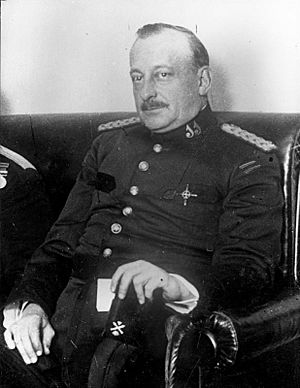
A few months after taking power, Primo de Rivera decided that just "cleaning up" the country wasn't enough. He believed a "new politics" was needed, supported by "people of healthy ideas" who would form a "political party, but apolitical." This party would focus on managing the State, following the idea of "less politics, more administration."
To build this new party, Primo de Rivera first considered a group in Barcelona that copied fascism. But after visiting Italy in November 1923, he chose to base his party on Catholic right-wing groups. This led to the creation of the Unión Patriótica Castellana (UPC), which aimed to be like the Catholic Partito Popolare Italiano. The UPC's first president was a Catholic professor, and its early ideas were based on traditional, corporatist Catholicism, supporting property and farming values.
On April 5, 1924, Primo de Rivera wrote to government delegates, telling them to "unite and organize all men of good will." Ten days later, he explained his plan: to build a "political party but which is apolitical" that would "unite all Spaniards of good will" based on "Religion, Homeland and Monarchy." This was similar to the Carlist motto "God, Homeland and King." The new group would not have an ideology and would be against the old Constitution. Its role would be to "excite the spirit of citizenship" so that it could form a parliamentary majority for the King. On April 29, he told civil governors to create UPT committees, and many of these committees were then appointed to form the new town councils. So, the Patriotic Union was a party "organized from power and for power."
Primo de Rivera described the Patriotic Union as "a central, monarchical, moderate and serenely democratic party." One of its thinkers, José María Pemán, said it was different from fascism and defended a "traditional social-Christian" state. He also rejected universal suffrage (the right for everyone to vote). The party was made up of traditional Catholics, conservatives, "apolitical" people, and those who simply saw an opportunity.
The Patriotic Union was mainly organized at the local and provincial levels. The national leadership didn't have very clear roles. The newspaper La Nación, supported by government funds, was important for connecting the party.
However, the Patriotic Union wasn't very effective at getting rid of caciquismo. Many former caciques joined its ranks, and new ones even appeared. For example, in Primo de Rivera's home province of Cadiz, almost all the traditional caciques joined the Patriotic Union.
Spanish Nationalism and Regionalism
From "Healthy Regionalism" to "Spanishism"
The statement Primo de Rivera made when he took power on September 13 mentioned "shameless separatist propaganda" as a reason for the coup. Five days later, a decree was issued against "separatism," punishing "crimes against the security and unity of the Homeland" with military trials. The dictatorship immediately chose a strong and aggressive Spanish nationalism. Symbols and groups related to other nationalisms were targeted. Censorship greatly reduced not only democratic and worker newspapers but also publications in other languages. Political activities were severely limited, and regional nationalisms were forced to disappear until 1929.
However, at first, Primo de Rivera seemed to support "healthy regionalism." A few days after the coup, he asked the Basque provincial councils to create a draft for a new regional law. The Provincial Council of Guipúzcoa did this, but the Vizcaya council opposed it, and the project was dropped. Primo de Rivera also said he wanted to replace the 49 small provincial administrations with 10, 12, or 14 regions that would have more power while staying part of Spain. He even offered a Galician commonwealth to conservative Galician nationalists if they cooperated. Similar offers were made to Valencian and Aragonese regionalists. In March 1924, a draft for the Galician Mancomunidad was approved, but by then, the dictatorship's interest in regionalism had faded.
On January 13, 1924, Primo de Rivera dissolved the provincial councils, except for those in the Basque Country and Navarre. Civil governors appointed their new members from professionals and business people. These new councils were supposed to report on problems and suggest solutions.
The appointment of strong "Spanishists" to lead the Catalan provincial councils, as had happened with the city councils, upset the members of the Lliga Regionalista, who had initially believed Primo de Rivera would support regionalism.
Primo de Rivera gave the job of reforming local and provincial government to José Calvo Sotelo, a conservative lawyer. Calvo Sotelo and his team worked on the Municipal Statute of 1924 and the Provincial Statute of 1925.
In a long note explaining the Provincial Statute, Primo de Rivera admitted he had changed his mind about "regionalism." He used to think it could help Spain, but now he believed that "to rebuild the region from power, to reinforce its personality, to exalt the differentiating pride between some and others is to contribute to undo the great work of national unity."
Language and Culture in Catalonia
The "nationalizing" program also reached schools, where "patriotic" and religious education was to be taught. On October 27, 1923, a rule was published reminding teachers to "teach the Castilian language in their respective schools and to teach in the same language." Later, inspectors could close schools or suspend teachers who didn't follow this. On October 13, 1925, school directors were ordered to watch for "antisocial doctrines or against the unity of the Fatherland." Books not written in Castilian or that went against national unity had to be removed, and teachers using them would be suspended.
In Catalonia, it quickly became clear that the Lliga Regionalista was wrong to support Primo de Rivera's coup. He immediately started a policy of persecuting Catalan nationalism. Among other things, Catalan was banned in official events. Attempts were made to stop its use in sermons, Spanish was made the only administrative language, Catalan place names were changed to Spanish, and the Jocs Florals (a Catalan poetry contest) were boycotted and had to be held abroad. Raising the Catalan flag was forbidden, Sardana dancing was limited, and professional, union, and sports groups were targeted just for using Catalan. This led to many conflicts with Catalan institutions that refused to accept these rules, and many were temporarily or permanently closed.
In January 1924, Primo de Rivera met with Catalan political leaders in Barcelona but only got support from the Spanish National Monarchist Union. Its leader, Alfonso Sala Argemí, became president of the Mancomunitat after Puig i Cadafalch resigned. However, Sala eventually disagreed with the military authorities in Catalonia and protested to Primo de Rivera. So, when the Provincial Statute of 1925 was approved on March 12, 1925, which effectively ended the Mancomunitat, Sala resigned.
After the Mancomunitat disappeared, Primo de Rivera's statements about Catalan culture, identity, language, and institutions became harsher. He strongly opposed any regional self-rule. As historian Genoveva García Queipo de Llano noted, "Primo de Rivera offended not only political groups but the whole of Catalan society." This led to growing distance between Catalonia and the dictatorship, with conflicts increasing. Acció Catalana took the "Catalan case" to the League of Nations, and Francesc Macià, a former military man who founded Estat Catalá, became a symbol of Catalonia's resistance to the dictatorship.
Repression of Basque Nationalism
The dictatorship also harshly repressed Basque nationalism, especially the more radical part of the Basque Nationalist Party (PNV). The moderate part had formed its own group. Only a week after the Directory was formed, its unofficial newspaper, Aberri, was closed, and PNV centers were shut down, effectively making the party illegal. However, a more moderate Basque group was somewhat tolerated. In 1924, its Guipuzcoa branch rejected separatism and stopped its political activities.
Both the PNV and the other Basque nationalist groups then focused on religious activities (like pilgrimages), leisure activities (like hiking), cultural activities (dance, theater, music, promoting the Basque language), and sports (soccer and cycling).
Peace in Morocco
From Retreat to Victory
Regarding the "Morocco problem," General Primo de Rivera had always wanted to pull troops out. So, he ordered a withdrawal to the coastal area of the Spanish Protectorate in Morocco. This upset the "Africanist" officers in the Army, who had gained quick promotions for their service in Africa. One such officer was Lieutenant Colonel Francisco Franco, who wrote articles defending Spanish colonialism. He had been promoted very quickly because of the war.
In March 1924, Primo de Rivera ordered troops to withdraw from the Yebala and Xauen areas to shorten the front lines. But the withdrawal happened in terrible weather, and Abd el-Krim, the leader of the Rif Republic, used this chance to attack. The operation was a disaster, with more casualties than the disaster of Annual three years earlier. Abd el-Krim took control of a large part of the Spanish protectorate. Primo de Rivera managed to hide the full extent of the disaster from the public through censorship. But in October 1924, he had to take personal command as the Spanish High Commissioner in Morocco. Only when the Rif rebels made the mistake of attacking French positions in spring 1925 did Primo de Rivera manage to save the situation.
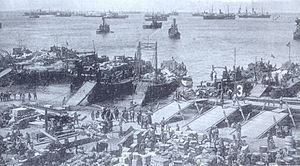
Abd el-Krim's attack on French-controlled areas in Morocco finally made France willing to work with Spain to end the Rif rebellion. This led to the plan for the Al Hoceima landing in September 1925. This operation was a complete success because it attacked the enemy from behind and split the rebel-controlled area in two. In April 1926, Abd el-Krim asked for talks, and by the next year, Morocco was completely peaceful, no longer a problem for Spain. Abd el-Krim surrendered to the French, who sent him to Reunion Island.
Who Was Responsible?
Once the parliament was closed and documents about the responsibilities for the Annual disaster were seized, the trials for military officers accused in the disaster were handled by the Supreme Council of War and Navy. On February 25, General Cavalcanti was found not guilty, which led the president of the Supreme Council to resign. Four months later, on June 19, the trial began against General Dámaso Berenguer and other officers involved. Dámaso Berenguer was forced to leave active service, but others were found not guilty or received light sentences. In July 1927, Primo de Rivera gave amnesty (a pardon) to Berenguer and the others. This way, the disagreements within the Army over who was responsible were finally put to rest.
Images for kids
See also
 In Spanish: Directorio militar de Primo de Rivera para niños
In Spanish: Directorio militar de Primo de Rivera para niños


